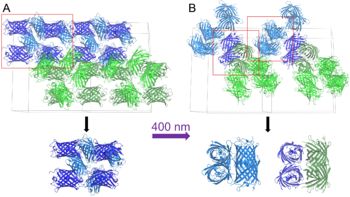Journal:IUCrJ:S2052252519005761
From Proteopedia
(Difference between revisions)

| Line 7: | Line 7: | ||
We discovered that crystals of a reversibly switchable fluorescent protein Tetdron can undergo the martensitic transformation by illumination with 400 nm light at room temperature. The phase transition results in the protein in crystallo tetramerization coupled to the chromophore deprotonation and substantial changes in the crystal packing as demonstrated by X-ray photocrystallography and spectroscopic measurements. | We discovered that crystals of a reversibly switchable fluorescent protein Tetdron can undergo the martensitic transformation by illumination with 400 nm light at room temperature. The phase transition results in the protein in crystallo tetramerization coupled to the chromophore deprotonation and substantial changes in the crystal packing as demonstrated by X-ray photocrystallography and spectroscopic measurements. | ||
The remarkable property of Tetdron crystals to undergo the photo-induced martensitic transformation can be explored to create novel martensitic biomaterials such as biomachines for biomedical applications, in which a protein molecule would play a role of a tiny molecular nanomachine to produce work. Tetdron may also find applications in future data storage devices with extreme capacities since 1 petabits of data can theoretically be written inside a Tetdron crystal measuring only 1 mm on a side. | The remarkable property of Tetdron crystals to undergo the photo-induced martensitic transformation can be explored to create novel martensitic biomaterials such as biomachines for biomedical applications, in which a protein molecule would play a role of a tiny molecular nanomachine to produce work. Tetdron may also find applications in future data storage devices with extreme capacities since 1 petabits of data can theoretically be written inside a Tetdron crystal measuring only 1 mm on a side. | ||
| + | |||
| + | [[Image:Figure4_iucrb.jpg|thumb|Crystal packing in Tetdron showing a super cell along the b axis. (A) Tetdron in the equilibrium state with a single asymmetric unit below. (B) Tetramers of the 400 nm irradiated Tetdron that form within the same asymmetric unit (blue) and with neighbouring asymmetric unit (blue and green). Red boxes indicate the molecules that were used to generate the images shown immediately under the super cells.|350px|left]] | ||
<b>References</b><br> | <b>References</b><br> | ||
Revision as of 11:52, 29 April 2019
| |||||||||||
This page complements a publication in scientific journals and is one of the Proteopedia's Interactive 3D Complement pages. For aditional details please see I3DC.

